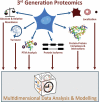Advancing cell biology through proteomics in space and time (PROSPECTS)
- PMID: 22311636
- PMCID: PMC3316737
- DOI: 10.1074/mcp.O112.017731
Advancing cell biology through proteomics in space and time (PROSPECTS)
Abstract
The term "proteomics" encompasses the large-scale detection and analysis of proteins and their post-translational modifications. Driven by major improvements in mass spectrometric instrumentation, methodology, and data analysis, the proteomics field has burgeoned in recent years. It now provides a range of sensitive and quantitative approaches for measuring protein structures and dynamics that promise to revolutionize our understanding of cell biology and molecular mechanisms in both human cells and model organisms. The Proteomics Specification in Time and Space (PROSPECTS) Network is a unique EU-funded project that brings together leading European research groups, spanning from instrumentation to biomedicine, in a collaborative five year initiative to develop new methods and applications for the functional analysis of cellular proteins. This special issue of Molecular and Cellular Proteomics presents 16 research papers reporting major recent progress by the PROSPECTS groups, including improvements to the resolution and sensitivity of the Orbitrap family of mass spectrometers, systematic detection of proteins using highly characterized antibody collections, and new methods for absolute as well as relative quantification of protein levels. Manuscripts in this issue exemplify approaches for performing quantitative measurements of cell proteomes and for studying their dynamic responses to perturbation, both during normal cellular responses and in disease mechanisms. Here we present a perspective on how the proteomics field is moving beyond simply identifying proteins with high sensitivity toward providing a powerful and versatile set of assay systems for characterizing proteome dynamics and thereby creating a new "third generation" proteomics strategy that offers an indispensible tool for cell biology and molecular medicine.
Figures


References
-
- Aebersold R., Mann M. (2003) Mass spectrometry-based proteomics. Nature 422, 198–207 - PubMed
-
- Cravatt B. F., Simon G. M., Yates J. R., 3rd (2007) The biological impact of mass-spectrometry-based proteomics. Nature 450, 991–1000 - PubMed
-
- Bantscheff M., Schirle M., Sweetman G., Rick J., Kuster B. (2007) Quantitative mass spectrometry in proteomics: a critical review. Anal. Bioanal. Chem. 389, 1017–1031 - PubMed
-
- Olsen J. V., de Godoy L. M., Li G., Macek B., Mortensen P., Pesch R., Makarov A., Lange O., Horning S., Mann M. (2005) Parts per million mass accuracy on an Orbitrap mass spectrometer via lock mass injection into a C-trap. Mol. Cell. Proteomics 4, 2010–2021 - PubMed
-
- Olsen J. V., Schwartz J. C., Griep-Raming J., Nielsen M. L., Damoc E., Denisov E., Lange O., Remes P., Taylor D., Splendore M., Wouters E. R., Senko M., Makarov A., Mann M., Horning S. (2009) A dual pressure linear ion trap Orbitrap instrument with very high sequencing speed. Mol. Cell. Proteomics 8, 2759–2769 - PMC - PubMed
Publication types
MeSH terms
Substances
Grants and funding
LinkOut - more resources
Full Text Sources

